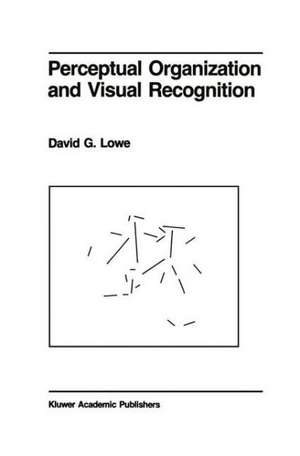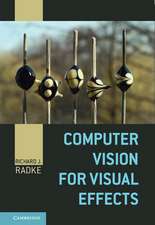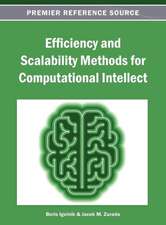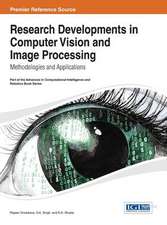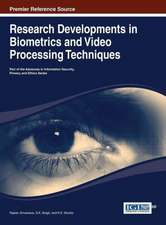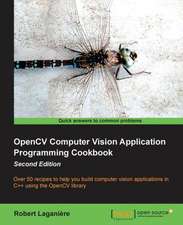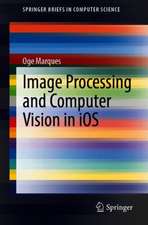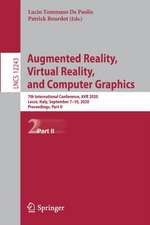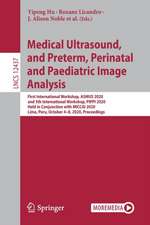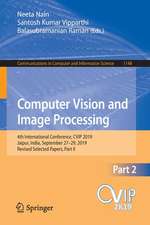Perceptual Organization and Visual Recognition: The Springer International Series in Engineering and Computer Science, cartea 5
Autor D. Loween Limba Engleză Hardback – 30 iun 1985
| Toate formatele și edițiile | Preț | Express |
|---|---|---|
| Paperback (1) | 639.52 lei 6-8 săpt. | |
| Springer Us – 30 sep 2011 | 639.52 lei 6-8 săpt. | |
| Hardback (1) | 645.79 lei 6-8 săpt. | |
| Springer Us – 30 iun 1985 | 645.79 lei 6-8 săpt. |
Din seria The Springer International Series in Engineering and Computer Science
- 24%
 Preț: 1041.98 lei
Preț: 1041.98 lei - 20%
 Preț: 643.50 lei
Preț: 643.50 lei - 18%
 Preț: 1225.62 lei
Preț: 1225.62 lei - 18%
 Preț: 965.02 lei
Preț: 965.02 lei - 20%
 Preț: 646.12 lei
Preț: 646.12 lei - 18%
 Preț: 948.79 lei
Preț: 948.79 lei - 20%
 Preț: 646.62 lei
Preț: 646.62 lei - 15%
 Preț: 637.46 lei
Preț: 637.46 lei - 20%
 Preț: 643.83 lei
Preț: 643.83 lei - 18%
 Preț: 949.23 lei
Preț: 949.23 lei - 20%
 Preț: 644.48 lei
Preț: 644.48 lei - 20%
 Preț: 994.92 lei
Preț: 994.92 lei - 20%
 Preț: 645.97 lei
Preț: 645.97 lei - 18%
 Preț: 946.87 lei
Preț: 946.87 lei - 20%
 Preț: 995.57 lei
Preț: 995.57 lei - 18%
 Preț: 956.99 lei
Preț: 956.99 lei - 20%
 Preț: 644.98 lei
Preț: 644.98 lei - 15%
 Preț: 649.54 lei
Preț: 649.54 lei - 18%
 Preț: 950.21 lei
Preț: 950.21 lei - 18%
 Preț: 1221.38 lei
Preț: 1221.38 lei - 18%
 Preț: 957.62 lei
Preț: 957.62 lei - 15%
 Preț: 643.99 lei
Preț: 643.99 lei - 18%
 Preț: 948.47 lei
Preț: 948.47 lei - 18%
 Preț: 947.35 lei
Preț: 947.35 lei - 20%
 Preț: 1284.65 lei
Preț: 1284.65 lei - 20%
 Preț: 1628.31 lei
Preț: 1628.31 lei - 20%
 Preț: 1285.78 lei
Preț: 1285.78 lei
Preț: 645.79 lei
Preț vechi: 807.24 lei
-20% Nou
Puncte Express: 969
Preț estimativ în valută:
123.58€ • 132.14$ • 103.03£
123.58€ • 132.14$ • 103.03£
Carte tipărită la comandă
Livrare economică 18 aprilie-02 mai
Preluare comenzi: 021 569.72.76
Specificații
ISBN-13: 9780898381726
ISBN-10: 089838172X
Pagini: 162
Ilustrații: XII, 162 p.
Dimensiuni: 155 x 235 x 11 mm
Greutate: 0.43 kg
Ediția:1985
Editura: Springer Us
Colecția Springer
Seria The Springer International Series in Engineering and Computer Science
Locul publicării:New York, NY, United States
ISBN-10: 089838172X
Pagini: 162
Ilustrații: XII, 162 p.
Dimensiuni: 155 x 235 x 11 mm
Greutate: 0.43 kg
Ediția:1985
Editura: Springer Us
Colecția Springer
Seria The Springer International Series in Engineering and Computer Science
Locul publicării:New York, NY, United States
Public țintă
ResearchCuprins
1. Introduction.- 1.0 Overview of spatial vision.- 1.1 Two viewpoints on computer vision.- 1.2 A demonstration of perceptual organization.- 1.3 Specific functions of perceptual organization.- 2. Previous Research.- 2.1 Gestalt psychology and perceptual organization.- 2.2 The principle of simplicity.- 2.3 Grouping as the formation of causal relations.- 2.4 The role of grouping in computer vision systems.- 3. The Significance of Image Relations.- 3.1 Probability of accidental occurrence.- 3.2 Limiting computational complexity.- 3.3 Conclusions.- 4. The Segmentation of Image Curves.- 4.1 Previous research on curve segmentation.- 4.2 Significance of a curve segmentation.- 4.3 Selecting the most significant structures.- 4.4 Demonstration of the algorithm.- 4.5 Evaluation and future research.- 5. The Use of Viewpoint Invariance.- 5.1 Three-space inferences from image features.- 5.2 Recovery of 3D properties from line drawings.- 5.3 A demonstration of three-space inference.- 5.4 Conclusions and future development.- 6. Model-based Search and Inference.- 6.1 Searching the space of possible viewpoints.- 6.2 Searching the space of possible objects.- 6.3 Summary.- 7. The Verification of Interpretations.- 7.1 Viewpoint determination in human vision.- 7.2 Definition of the problem.- 7.3 Previous research on viewpoint determination.- 7.4 Formulation of perspective projection.- 7.5 Newton-Raphson convergence.- 7.6 Solving for model parameters.- 7.7 Matching lines instead of points.- 7.8 Implementation and future research.- 8. The Scerpo Vision System.- 8.1 Edge detection.- 8.2 Perceptual organization.- 8.3 Matching and evidential reasoning.- 8.4 Verification.- 8.5 System performance and future extensions.- 9. Conclusions.- 9.1 Directions for future development.- Bibliographic Index.
